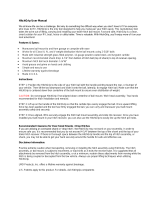
2013 NISSAN Towing Guide
8
will allow the chains/cables to drag on the ground.
Do not use S-hooks for attaching, as they may become un-hooked and are illegal in many
states. To avoid damage to the bumper and chains/cables when making a sharp turn, do not
attach the chains/cables too close to the coupler. Consult your trailer manufacturer for the
proper location of the chain/cable attachment to the trailer.
REAR VIEW MIRRORS
In many cases, a trailer can block your rear vision when you are using only the standard
NISSAN rear view mirrors. These mirrors were not designed for towing. “Extended” mirrors
specifically designed for trailer towing should be used when your rearward vision is
obstructed. Before using these mirrors, make certain that they comply with state and local
regulations. Telescoping Tow Mirrors are available as an accessory for certain Nissan vehicles.
Contact your NISSAN dealer for details.
BREAKAWAY SWITCH
On a trailer with electric brakes, a breakaway switch can automatically activate the trailer
brake system if the trailer becomes separated from the tow vehicle. Should the trailer become
detached, a breakaway switch may help prevent the trailer from wandering into another lane.
A breakaway switch relies on the power of a trailer battery, so make sure it is not
discharged. Never use the breakaway switch to “park” the trailer on a grade. The battery
would eventually discharge and release the brake, allowing the trailer to roll. Be sure to leave
enough slack in the tether on the breakaway switch to turn corners without binding. If you do
not, the electric trailer brakes will lock-up and not release. See your trailer manufacturer for
proper installation of a breakaway switch that is compatible with your trailer braking system.
TRAILER LIGHTS
Trailer lights should comply with all applicable federal, state, and local regulations, and should
be in proper working order at all times. A trailer’s taillights, stoplights, and turn signal lights
must be wired into the tow vehicle’s electrical system.*
Most trailers operate on a four-wire system in which the stoplights and turn signal lights
utilize the same wire. Most all NISSAN vehicles have separate wires for the stoplights and turn
signal lights, therefore a device called a “converter” is needed.** Specifically, a “powered
* Vehicles equipped with LED taillights require that wiring be connected at a specific location. For
assistance in hooking up trailer lights, contact your NISSAN dealer or a professional supplier of
towing
equipment.
** Armada, Frontier, Pathfinder, and Titan, vehicles are pre-wired for trailer lighting and do not require a
converter. If your vehicle is equipped with a 4-pin connector, an adapter will be needed to connect
the trailer lights to the vehicle.





















